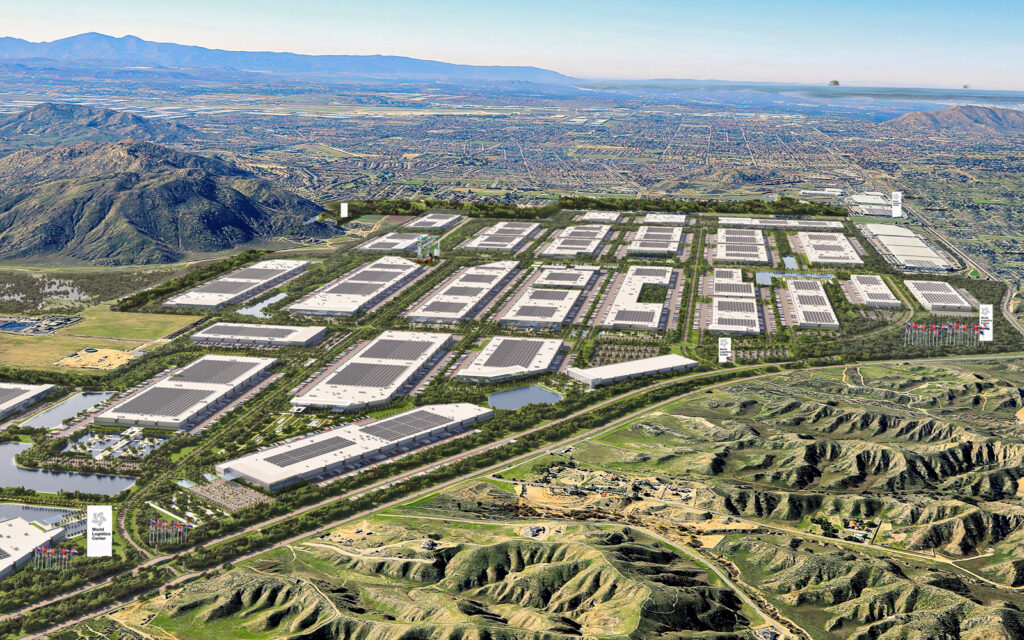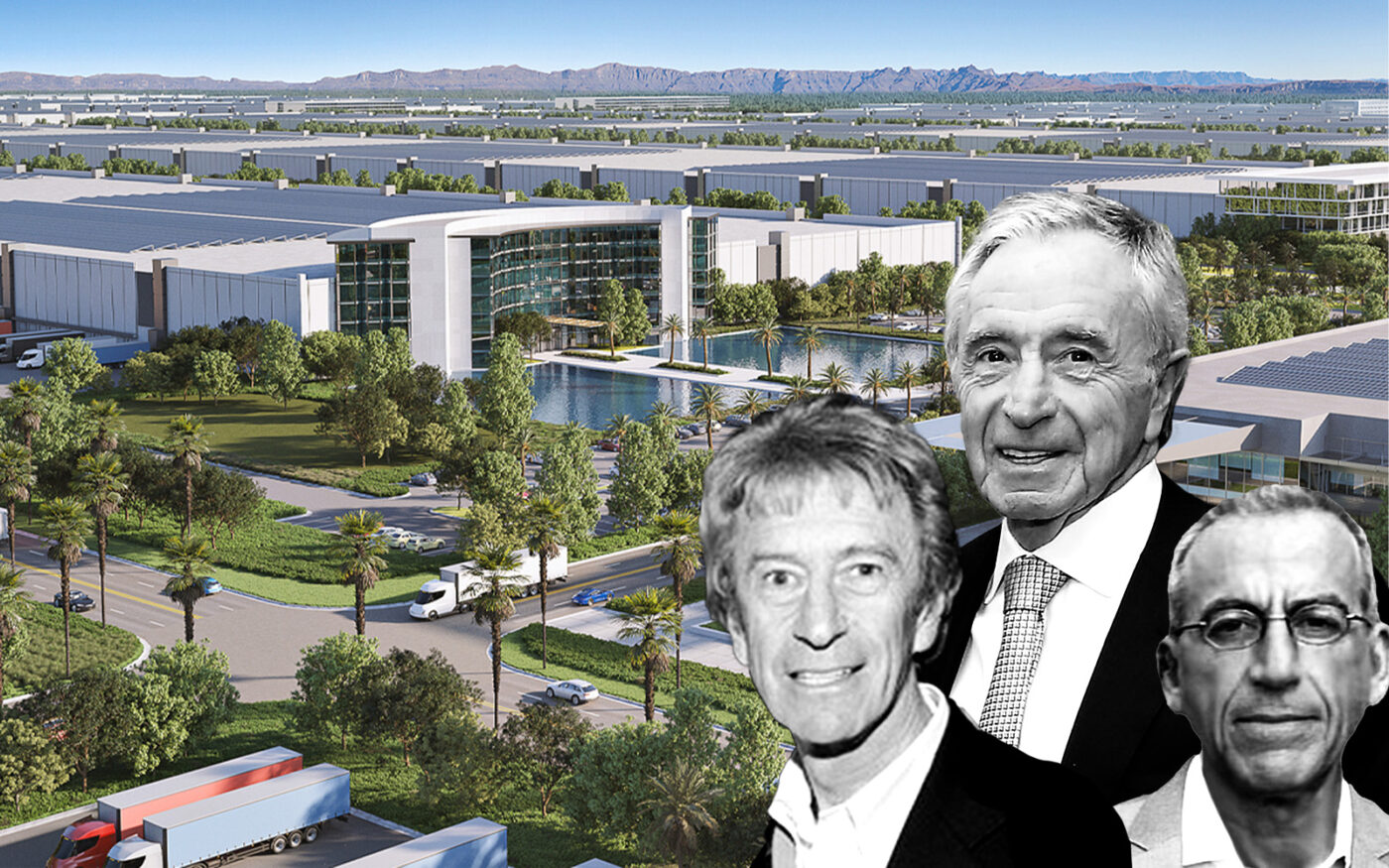Few people outside of Southern California have ever heard of Moreno Valley, a small city 60 miles east of Downtown Los Angeles. It’s certainly not the type of place where you’d expect to find luxury developers from Miami.
But Jules and Eddie Trump know it well.
The South African expats, best known for their dazzling high-profile oceanfront condo towers in South Florida, have spent the past 20 years pursuing an under-the-radar play in California’s Inland Empire.
Through a partnership with Iddo Benzeevi, a local developer the Trumps tapped as CEO of their Highland Fairview, the brothers are planning a 41 million-square-foot megadevelopment with 27 massive logistics facilities across five square miles. If completed, the result will be a warehouse city roughly four times the size of Manhattan’s Central Park.
On a recent Friday morning, Benzeevi stood overlooking the sprawling development site running east of Redlands Boulevard and south of California State Route 60, something like Mufasa in “The Lion King” surveying his domain.
“We stopped counting after 30,” he replied when asked how many parcels of land he and the Trump brothers stitched together for the project.
The development is unusual for the Trumps (no relation to the former president), who took a risk buying up land in Moreno Valley in the early 2000s, before the e-commerce boom that brought players like Amazon to gobble up space with buys or leases for one massive logistics center after another.
Now the risk is whether demand for industrial properties will still be as strong once construction — slated to start later this year — is completed. Major occupants, including Amazon and FedEx, have drastically slowed plans to open new logistics centers. The Trumps and Benzeevi will also have to compete with institutional players, like Prologis and Blackstone, who are building Inland Empire projects of their own.
“No, we haven’t missed the boat,” Jules Trump said. “The growth of online retailing is unstoppable.”
Piecing the puzzle together
In 2002, Benzeevi had an idea. He wanted to start compiling acreage in Moreno Valley, which he identified as the center of the Inland Empire and a pivotal geographic point for distribution.
He thought he had enough evidence to convince an equity partner. Thanks to an increase in trading with Asia, the Port of Los Angeles and Port of Long Beach made up the busiest port complex in the U.S. The Alameda Corridor, allowing for more direct freight train access to the ports, had just been completed.
He wasn’t the only one looking to cash in. Future Prologis CEO Hamid Moghadam was running AMB Property, which by 2002 had started partnering with other developers to build its own warehouses. Ed Roski, Jr., the CEO of Majestic Realty, built his first 1 million-square-foot-plus building in 1988.
“We haven’t missed the boat. The growth of online retailing is unstoppable.”
Jules Trump
The race was on, but Benzeevi needed cash to compete.
“Somehow he got a hold of my name, and he started calling me very, very persistently” Jules said.
Benzeevi wore Jules down, and eventually, the Trump brothers flew out to the chaparral country of the Inland Empire to see what his plan was about. They bought into the vision, both theoretically and financially.
The trio started assembling land, most of which was owned by local farmers. It was a lot of cold calling and door-to-door visits, Benzeevi said. Eventually, they bought upwards of 50 parcels.
Jules described the process as “excruciating.” Everything was purchased with the Trumps’ money, and there’s no debt on the land, he said.
The bulk of the acquisitions were made between 2003 and 2007, a period of time when Riverside County records did not disclose transfer taxes or sale prices in property records, making it unclear how much the Trumps spent in total.
The average cost of a single acre of farmland in Riverside County was $4,830 in 2002 and had risen to almost $16,000 by 2007. Highland Fairview now owns more than 3,000.
Building a reputation
It had the land, now it needed a building. And a tenant.
Benzeevi said the firm needed a “proof of concept” — something to show the city of Moreno Valley, other developers and potential tenants that Highland Fairview could build, and build well.
In 2010, on the northernmost parcel it owned, Highland Fairview was marketing a 1.8 million-square-foot facility. It scored sneaker company Skechers, which decided to consolidate five distribution centers into one.
Like most industrial developments, the warehouse was a build-to-suit — Skechers told the developers what it needed, and they accommodated. The building was finished in 2011.
Apart from a second building, completed last year, that expanded Skechers’ space by another 768,000 square feet, Highland Fairview hasn’t built anything else since. Instead, it’s been focused on planning and obtaining city approvals for its five-square-mile development, dubbed the World Logistics Center.
Fortunately for Benzeevi and the Trumps, the city was on board, they said.
“Generally, if you’re doing what they want and it’s a good product, it’s much easier to do it,” Eddie Trump said.
Neither the city’s planning department nor the mayor’s office responded to requests for comment.

In 2006, Moreno Valley was aware that its industrial sector was growing and that it needed to adapt by rezoning and allowing for commercial redevelopment, according to its general plan. After Skechers arrived, along with hundreds of jobs, the city’s interest spiked, according to Benzeevi.
The firm formally filed plans to build the World Logistics Center in 2011.
But major developments in California are subject to review under the California Environmental Quality Act — legislation often condemned by developers and YIMBYs for causing litigation and years-long delays.
Under CEQA, project developers also have to submit environmental reviews. The World Logistics Center’s environmental impact review sits in Highland Fairview’s office in Moreno Valley: more than 40,000 pages across 28 four-inch thick white binders.
Environmental and conservation groups challenged the project numerous times, first in 2015 for allegedly failing to mitigate surrounding air pollution and threats to local endangered wildlife.
“We don’t need yet another sprawling mega-project that makes our air dirtier, our climate hotter and our roads more congested,” George Hague of Sierra Club’s Moreno Valley Group said in 2018.
In 2021, the environmental litigation was settled. Highland Fairview agreed to fund purchases of 500 heavy-duty electric trucks, a $1.1 million clean vehicle program for Moreno Valley residents and install rooftop solar panels, among other requirements, according to the settlement agreement.
“It was a lengthy process,” Benzeevi said.
Navigating waning demand
After doubling its real estate footprint in 2021, Amazon, the nation’s largest industrial tenant, abruptly slammed the brakes on its expansion last year. FedEx has slowed its growth, too.
Jules and Eddie Trump both shrugged that off.
“It’s normal for companies to rebalance,” Jules said. “They expanded like crazy and there’s a greater cost consciousness.”
Another challenge facing any commercial project that hopes to break ground this year is financing — with high interest rates clamping up debt markets, scoring millions of dollars for construction is not easy.
Jules said he’s willing to pour more cash into the project if necessary, but isn’t willing to sell or bring on another equity partner.
The development will also be done in phases, so Highland Fairview doesn’t need to finance its construction all at once, Benzeevi said.
But the Trumps and Benzeevi will have to compete for tenants, too, as institutional players plow into industrial construction. About 21 million square feet of warehouse space was under construction at the end of 2019. At the end of last year, that had nearly doubled to more than 37 million square feet.
Still, the Inland Empire’s industrial market remains extremely tight, with a vacancy rate of just 1.1 percent at the end of last year, according to CBRE. Given the challenges with CEQA and movement in the California state assembly to restrict warehouse development, the Trumps believe they got in at the right time.
“Supply is being constrained and fewer things will be built by others,” Eddie said. “We’re very, very lucky.”
The trio thinks — or hopes — that online shopping’s enduring appeal will be enough to lure new tenants to its warehouse kingdom.
“It’s the underlying infrastructure that supports all of our commerce,” Benzeevi said. “It’ll be here to stay.”
Correction: An earlier version of this story stated that Highland Fairview had not built anything else on the site of the World Logistics Center since 2011. A second building, also leased by Skechers, was completed in 2022.

